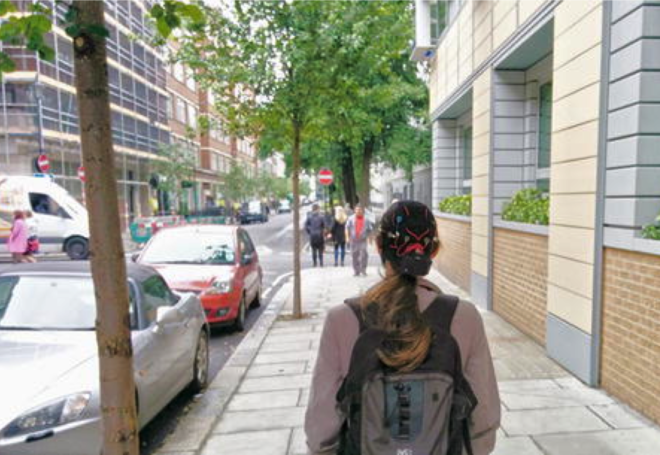Using EEG to understand the relationship between the human mind and its environment. A future where machines, buildings and environments can better adapt to human bodies, minds, and purpose is not far away.
Imagine a subject in a traditional EEG or fMRI study of spatial cognition; the subject sits or lies, stock-still, festooned with electrodes and cables, or surrounded by humming machines, in a windowless laboratory, insulated from the sounds, sights, and electromagnetic fields of the outside world, absorbed in making their way through a simulated environment on a computer screen, or a 3-D goggle display.
What’s wrong with this picture?
It is reasonable to suspect that the brain activity of subjects in such a situation does not represent subjects physically navigating their way through an urban landscape, a home, or a freeway system. Laboratory studies of spatial cognition have had interesting results; theta activity “under the frontal midline area—above the forehead” has been correlated with both working memory load and the difficulty of navigation tasks (cited in Geo-EEG). In order to find out if these results reflect non-simulated human navigation, researchers need to record subjects as they move through spaces.
At the least, mobile studies of brain activity could ascertain whether laboratory simulation results can teach us about un-simulated activity. At best, they could open new realms of human activity to neuroscientific study. One might study people at play, at work, at school, shopping, responding to architecture and streets, encountering noise, peace, pollution, nature, and advertising. This kind of knowledge could benefit human wellness through application by architects, urban planners and designers, social psychologists, educators, healers, and artists. Neuroscientists wanting to break new ground or, at least get off the bandwagon, would do well to consider the possibilities.
Studying the interaction of mind and urban environment
In “Geo-EEG: Towards the Use of EEG in the Study of Urban Behavior,” a British research team discusses applications of mobile EEG, especially for the study of spatial cognition and human responses to environmental conditions. “Environmental psychophysiology” say the authors, “studies the relationship and the transactions between humans and their environments; how, for example, the presence of green space, the amounts of noise or air pollution, the design of spaces, may affect levels of health, stress hormones, concentration and attention, wellbeing or productivity.” Such studies might use not only EEG, but also heart rate, skin conductivity, and endocrinological levels.
The authors of “Geo-EEG” piloted a mobile EEG study of “the restorative hypothesis” that urban green-zones relieve stress and its deleterious health effects. They found “evidence of lower frustration, engagement and arousal, and higher meditation when moving into the green space zone—and higher engagement when moving out of it.” This “Mood, Mobility and Place” (MMP) project continues now with a focus on how the design of spaces affects mood and attention in older people. Mobile EEG research along these lines could also be used to better adapt the designs of schools, hospitals, and vehicles to human needs.
Technologies of the future
The Geo-EEG authors also discuss futuristic applications of portable BCIs to create environments that change in response to user emotions and needs. Their CEDE (Creating and Exploring Digital Empathy) project adjusts ambient lighting in response to emotions, measured with an Emotiv EEG (see more about Emotiv here and here). The Philips corporation and Emotiv are partnering to develop home automation for patients with amyotrophic lateral sclerosis (ALS) – to control televisions, lighting, and Philips’ Medical Alert System. Between wireless, A.I., and BCI, environments may soon be made sentient, responding to needs, intentions and emotions.
All major manufacturers of EEG equipment now market mobile equipment and commercial systems capable of research-quality recordings are increasingly affordable. Newer EEG devices come with cross-platform capabilities and software tools, and more are available open-source, such as EEGLab, a Matlab plugin. Android software for mobile signal acquisition, filtering, and imaging, designed for use with Emotiv, is available from the Smartphone Brain Scanner project and other sources. The app relays data to laptops or tablets and synchronizes EEG records with the time-space parameters of the experiment – such as say, the route followed by a subject — using GPS records. The smartphones are simultaneously used for mobile task / stimulus presentation.
The challenges ahead
As we move towards this future however, there are substantial challenges that we need to solve. Stable long term use outside of an obviously experimental context is still ahead of us. Portable EEG headsets compromise stability for lower weight and cost and a portable device with a consistent and stable signal under ambulatory conditions requires a tight cap and a backpack that make you well aware that you are within an experimental paradigm (see Taking Neurotechnologies out of the Lab). The more significant challenge however is on interpretation of the signal (read What does the EEG signal measure?). With wide variation among human beings in their baseline brain function, interpretations of brain states are still rudimentary and can be unreliable. To get to reliable interpretation we must look at large scale data under different conditions, a key goal of the Sapien Labs Human Brain Diversity Project.
But we are on our way. We’re looking at a future where machines, buildings and environments can better adapt to human bodies, minds, and purposes.

